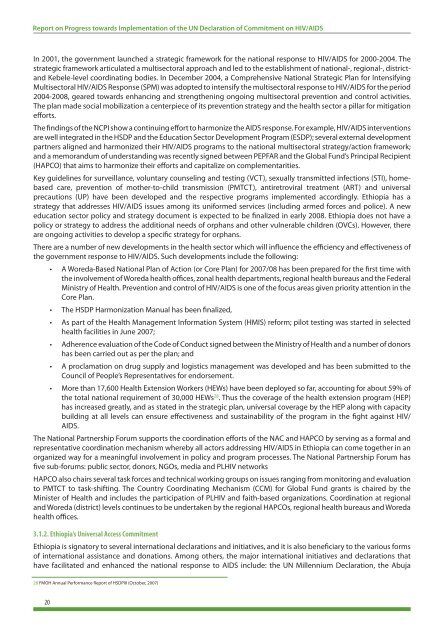Ethiopia - Country Progress Report - unaids
Ethiopia - Country Progress Report - unaids
Ethiopia - Country Progress Report - unaids
Create successful ePaper yourself
Turn your PDF publications into a flip-book with our unique Google optimized e-Paper software.
<strong>Report</strong> on <strong>Progress</strong> towards Implementation of the UN Declaration of Commitment on HIV/AIDS<br />
In 2001, the government launched a strategic framework for the national response to HIV/AIDS for 2000-2004. The<br />
strategic framework articulated a multisectoral approach and led to the establishment of national-, regional-, districtand<br />
Kebele-level coordinating bodies. In December 2004, a Comprehensive National Strategic Plan for Intensifying<br />
Multisectoral HIV/AIDS Response (SPM) was adopted to intensify the multisectoral response to HIV/AIDS for the period<br />
2004-2008, geared towards enhancing and strengthening ongoing multisectoral prevention and control activities.<br />
The plan made social mobilization a centerpiece of its prevention strategy and the health sector a pillar for mitigation<br />
efforts.<br />
The findings of the NCPI show a continuing effort to harmonize the AIDS response. For example, HIV/AIDS interventions<br />
are well integrated in the HSDP and the Education Sector Development Program (ESDP); several external development<br />
partners aligned and harmonized their HIV/AIDS programs to the national multisectoral strategy/action framework;<br />
and a memorandum of understanding was recently signed between PEPFAR and the Global Fund’s Principal Recipient<br />
(HAPCO) that aims to harmonize their efforts and capitalize on complementarities.<br />
Key guidelines for surveillance, voluntary counseling and testing (VCT), sexually transmitted infections (STI), homebased<br />
care, prevention of mother-to-child transmission (PMTCT), antiretroviral treatment (ART) and universal<br />
precautions (UP) have been developed and the respective programs implemented accordingly. <strong>Ethiopia</strong> has a<br />
strategy that addresses HIV/AIDS issues among its uniformed services (including armed forces and police). A new<br />
education sector policy and strategy document is expected to be finalized in early 2008. <strong>Ethiopia</strong> does not have a<br />
policy or strategy to address the additional needs of orphans and other vulnerable children (OVCs). However, there<br />
are ongoing activities to develop a specific strategy for orphans.<br />
There are a number of new developments in the health sector which will influence the efficiency and effectiveness of<br />
the government response to HIV/AIDS. Such developments include the following:<br />
• A Woreda-Based National Plan of Action (or Core Plan) for 2007/08 has been prepared for the first time with<br />
the involvement of Woreda health offices, zonal health departments, regional health bureaus and the Federal<br />
Ministry of Health. Prevention and control of HIV/AIDS is one of the focus areas given priority attention in the<br />
Core Plan.<br />
• The HSDP Harmonization Manual has been finalized,<br />
• As part of the Health Management Information System (HMIS) reform; pilot testing was started in selected<br />
health facilities in June 2007;<br />
• Adherence evaluation of the Code of Conduct signed between the Ministry of Health and a number of donors<br />
has been carried out as per the plan; and<br />
• A proclamation on drug supply and logistics management was developed and has been submitted to the<br />
Council of People’s Representatives for endorsement.<br />
• More than 17,600 Health Extension Workers (HEWs) have been deployed so far, accounting for about 59% of<br />
the total national requirement of 30,000 HEWs 28 . Thus the coverage of the health extension program (HEP)<br />
has increased greatly, and as stated in the strategic plan, universal coverage by the HEP along with capacity<br />
building at all levels can ensure effectiveness and sustainability of the program in the fight against HIV/<br />
AIDS.<br />
The National Partnership Forum supports the coordination efforts of the NAC and HAPCO by serving as a formal and<br />
representative coordination mechanism whereby all actors addressing HIV/AIDS in <strong>Ethiopia</strong> can come together in an<br />
organized way for a meaningful involvement in policy and program processes. The National Partnership Forum has<br />
five sub-forums: public sector, donors, NGOs, media and PLHIV networks<br />
HAPCO also chairs several task forces and technical working groups on issues ranging from monitoring and evaluation<br />
to PMTCT to task-shifting. The <strong>Country</strong> Coordinating Mechanism (CCM) for Global Fund grants is chaired by the<br />
Minister of Health and includes the participation of PLHIV and faith-based organizations. Coordination at regional<br />
and Woreda (district) levels continues to be undertaken by the regional HAPCOs, regional health bureaus and Woreda<br />
health offices.<br />
3.1.2. <strong>Ethiopia</strong>’s Universal Access Commitment<br />
<strong>Ethiopia</strong> is signatory to several international declarations and initiatives, and it is also beneficiary to the various forms<br />
of international assistance and donations. Among others, the major international initiatives and declarations that<br />
have facilitated and enhanced the national response to AIDS include: the UN Millennium Declaration, the Abuja<br />
28 FMOH Annual Performance <strong>Report</strong> of HSDPIII (October, 2007)<br />
20

















